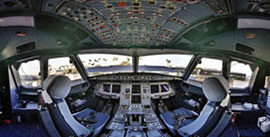US Airways Flight 1549
 The Airbus A320-214, under Captain Chesley Sullenberger, was flown by first officer Jeffrey Skiles when the flight, just two minutes after taking off from LaGuardia Airport, hit a flock of Canada geese, at 3:27 PM on January 15, 2009. The aircraft, headed for Charlotte, North Carolina, with 155 people on board, was hit in the windshield, and both engines swallowed one or two birds and simultaneously shut off. The two very experienced pilots were flying together for the first time. They had become an operational team while going through the pre-takeoff checklist, allowing them to verify the interoperability of their skill sets and their ability to function as a team at the command of their aircraft. They kept their cool as they peered through the blood-stained windshield in the suddenly frighteningly silent cockpit.
The Airbus A320-214, under Captain Chesley Sullenberger, was flown by first officer Jeffrey Skiles when the flight, just two minutes after taking off from LaGuardia Airport, hit a flock of Canada geese, at 3:27 PM on January 15, 2009. The aircraft, headed for Charlotte, North Carolina, with 155 people on board, was hit in the windshield, and both engines swallowed one or two birds and simultaneously shut off. The two very experienced pilots were flying together for the first time. They had become an operational team while going through the pre-takeoff checklist, allowing them to verify the interoperability of their skill sets and their ability to function as a team at the command of their aircraft. They kept their cool as they peered through the blood-stained windshield in the suddenly frighteningly silent cockpit.
Sullenberger immediately took over (15:27:23 Sullenberger: “my aircraft,” Skiles: “your aircraft”) from his copilot and started assessing the situation and his options as Skiles began to go through a three-page checklist to try and restart each engine in turn (15:27:28 Sullenberger: get the QRH... [Quick Reference Handbook]) loss of thrust on both engines.. Bad luck had it that they were still too low to reach any runway. Good luck had it that they had enough height to clear George Washington Bridge. The Airbus’s fly-by-wire technology somewhat facilitated the handling of the aircraft in these unusual circumstances. There is, however, no substitute for the cool-headed thinking (15:30:21 – Sullenberger: “Got any ideas?”) and perfect execution that only comes with repeated training, drills, and experience, even for a cockpit crew that had never met until 30 minutes earlier.
The simple instructions—“This is the captain. Brace for impact”—given 90 seconds before ditching were enough for the flight attendants to go through a well-rehearsed lifesaving routine. Their familiarity with the procedure allowed them to perform quickly and calmly, thereby avoiding panic setting in among the untrained passengers. The captain’s training led him to pick a location close to operating boats, allowing for a quick rescue. Getting the flaps out at the right time and hitting the “ditching button” to close openings that would otherwise let the water in were critical actions that were performed “by the book.”
Evacuating 155 very scared passengers is certainly not something that the three flight attendants could have improvised. Here, again, a well-designed protocol, drilled in through repeated training, kicked in when it was required. The plane was fully evacuated in three minutes—by the book again—in standard time. All passengers and crew got away with their lives, and there were only five serious injuries. This was one of the most successful ditchings of an airliner in history. Thank goodness for a good book—shared, trusted, and well understood by all—when it is time to act quickly and synchronously.
Analysis
It does not take anything away from the skills and human qualities of Captain Sullenberger to observe that flight 1549 did not simply avoid disaster because of the lone heroic actions of a superman. It did so because of the disciplined actions a team of well-trained, experienced, level-headed employees, acting responsibly according to procedures, using equipment designed and maintained with just such an event in mind, under able leadership. His decision to ditch in the Hudson was his to make and to assume. He did not wait for instructions to proceed. Indeed, this would most probably have meant disaster, as Sullenberger himself had the best information to assess the situation and with his team was in the best position to execute it. His actions, however, were totally in line with his training and best flying practice. The coordination system with his teammates and the air traffic controllers never broke down. In fact, the “framework” responded perfectly to the full and appropriate exercise of his freedom. Nothing else could have produced such a positive outcome.
Much effort and resources have been dedicated over the years at US Airways, Airbus, the Federal Aviation Administration (FAA), and the National Transportation Safety Board (NTSB), among others, toward building and continuously improving a quality system, that is, a system to ensure that desired customer outcomes are delivered reliably and flawlessly, even in the face of rare events. This investment and the resulting quality culture allowed all the players involved to communicate clearly and economically, to act effectively, and to coordinate seamlessly, even though they had never worked together prior to that day.
Designing and operating a quality system requires a thorough understanding of the nature of the task, of what could go wrong (failure modes), and of the best way to deal with such emergencies. Again, this does not require a stroke of genius, but dedicated, rigorous efforts over time to think risks through, learn from variations and defects, and use these lessons to continuously improve processes. Taking resources away from daily operations—with the immediate pain that this inflicts on the organization—to dedicate them to this long-term task, with no immediately visible benefits, requires vision, wisdom, strength, and leadership.
1 Excerpted from: HARVEY, J., « Complex service delivery processes: Strategy to operations », Second edition, American Society for Quality – Quality Press, Milwaukee: Wisconsin, 428 pages, 2011.
http://asq.org/quality-press/display-item/index.html?item=H1402